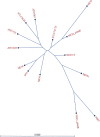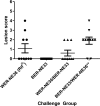Conjugation-Mediated Horizontal Gene Transfer of Clostridium perfringens Plasmids in the Chicken Gastrointestinal Tract Results in the Formation of New Virulent Strains
- PMID: 29030439
- PMCID: PMC5717208
- DOI: 10.1128/AEM.01814-17
Conjugation-Mediated Horizontal Gene Transfer of Clostridium perfringens Plasmids in the Chicken Gastrointestinal Tract Results in the Formation of New Virulent Strains
Abstract
Clostridium perfringens is a gastrointestinal pathogen capable of causing disease in a variety of hosts. Necrotic enteritis in chickens is caused by C. perfringens strains that produce the pore-forming toxin NetB, the major virulence factor for this disease. Like many other C. perfringens toxins and antibiotic resistance genes, NetB is encoded on a conjugative plasmid. Conjugative transfer of the netB-containing plasmid pJIR3535 has been demonstrated in vitro with a netB-null mutant. This study has investigated the effect of plasmid transfer on disease pathogenesis, with two genetically distinct transconjugants constructed under in vitro conditions, within the intestinal tract of chickens. This study also demonstrates that plasmid transfer can occur naturally in the host gut environment without the need for antibiotic selective pressure to be applied. The demonstration of plasmid transfer within the chicken host may have implications for the progression and pathogenesis of C. perfringens-mediated disease. Such horizontal gene transfer events are likely to be common in the clostridia and may be a key factor in strain evolution, both within animals and in the wider environment.IMPORTANCEClostridium perfringens is a major gastrointestinal pathogen of poultry. C. perfringens strains that express the NetB pore-forming toxin, which is encoded on a conjugative plasmid, cause necrotic enteritis. This study demonstrated that the conjugative transfer of the netB-containing plasmid to two different nonpathogenic strains converted them into disease-causing strains with disease-causing capability similar to that of the donor strain. Plasmid transfer of netB and antibiotic resistance was also demonstrated to occur within the gastrointestinal tract of chickens, with approximately 14% of the isolates recovered comprising three distinct, in vivo-derived, transconjugant types. The demonstration of in vivo plasmid transfer indicates the potential importance of strain plasticity and the contribution of plasmids to strain virulence.
Keywords: Clostridium perfringens; conjugation; in vivo plasmid transfer; necrotic enteritis; pathogenicity; virulence.
© Crown copyright 2017.
Figures





Similar articles
-
Necrotic enteritis-derived Clostridium perfringens strain with three closely related independently conjugative toxin and antibiotic resistance plasmids.mBio. 2011 Sep 27;2(5):e00190-11. doi: 10.1128/mBio.00190-11. Print 2011. mBio. 2011. PMID: 21954306 Free PMC article.
-
NetB and necrotic enteritis: the hole movable story.Avian Pathol. 2016 Jun;45(3):295-301. doi: 10.1080/03079457.2016.1158781. Avian Pathol. 2016. PMID: 27009522
-
A chicken intestinal ligated loop model to study the virulence of Clostridium perfringens isolates recovered from antibiotic-free chicken flocks.Avian Pathol. 2017 Apr;46(2):138-149. doi: 10.1080/03079457.2016.1228825. Epub 2016 Dec 5. Avian Pathol. 2017. PMID: 27917645
-
Necrotic enteritis in broilers: an updated review on the pathogenesis.Avian Pathol. 2011 Aug;40(4):341-7. doi: 10.1080/03079457.2011.590967. Avian Pathol. 2011. PMID: 21812711 Review.
-
The pathogenesis of necrotic enteritis in chickens: what we know and what we need to know: a review.Avian Pathol. 2016 Jun;45(3):288-94. doi: 10.1080/03079457.2016.1139688. Avian Pathol. 2016. PMID: 26813023 Review.
Cited by
-
Clostridium perfringens Associated with Foodborne Infections of Animal Origins: Insights into Prevalence, Antimicrobial Resistance, Toxin Genes Profiles, and Toxinotypes.Biology (Basel). 2022 Apr 1;11(4):551. doi: 10.3390/biology11040551. Biology (Basel). 2022. PMID: 35453750 Free PMC article.
-
Comparative in silico genome analysis of Clostridium perfringens unravels stable phylogroups with different genome characteristics and pathogenic potential.Sci Rep. 2021 Mar 24;11(1):6756. doi: 10.1038/s41598-021-86148-8. Sci Rep. 2021. PMID: 33762628 Free PMC article.
-
Virulence Plasmids of the Pathogenic Clostridia.Microbiol Spectr. 2019 May;7(3):10.1128/microbiolspec.gpp3-0034-2018. doi: 10.1128/microbiolspec.GPP3-0034-2018. Microbiol Spectr. 2019. PMID: 31111816 Free PMC article.
-
Genomics of the Pathogenic Clostridia.Microbiol Spectr. 2019 May;7(3):10.1128/microbiolspec.gpp3-0033-2018. doi: 10.1128/microbiolspec.GPP3-0033-2018. Microbiol Spectr. 2019. PMID: 31215504 Free PMC article. Review.
-
Draft Genome Sequence of Clostridium perfringens Strain TAMU, Which Causes Necrotic Enteritis in Broiler Chickens.Microbiol Resour Announc. 2020 Jan 23;9(4):e01357-19. doi: 10.1128/MRA.01357-19. Microbiol Resour Announc. 2020. PMID: 31974152 Free PMC article.
References
-
- Bannam TL, Yan X-X, Harrison PF, Seemann T, Keyburn AL, Stubenrauch C, Weeramantri LH, Cheung JK, McClane BA, Boyce JD, Moore RJ, Rood JI. 2011. Necrotic enteritis-derived Clostridium perfringens strain with three closely related independently conjugative toxin and antibiotic resistance plasmids. mBio 2(5):e00190-. doi:10.1128/mBio.00190-11. - DOI - PMC - PubMed
Publication types
MeSH terms
LinkOut - more resources
Full Text Sources
Other Literature Sources

